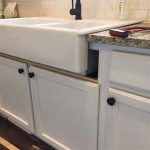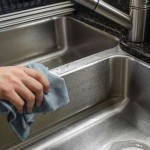Kitchen Sink Not Draining? Troubleshooting Your Garbage Disposal
A kitchen sink that refuses to drain, particularly when coupled with a garbage disposal, is a common household frustration. This issue can stem from various causes, ranging from simple obstructions to more complex plumbing problems. A systematic approach to diagnosis and troubleshooting is essential to resolve the problem efficiently and avoid potential damage to the disposal unit or the plumbing system.
Identifying the Root Cause
The first step in addressing a clogged kitchen sink with a garbage disposal is to accurately identify the source of the blockage. Several factors can contribute to this problem, and understanding each possibility is crucial for effective remediation.
Food Waste Accumulation: The primary function of a garbage disposal is to grind food waste into smaller particles suitable for disposal through the plumbing system. However, certain types of food, such as starchy substances (rice, pasta, potatoes), fibrous materials (celery, corn husks), and fats, oils, and grease (FOG), are notorious for causing clogs. These materials can accumulate within the disposal unit or the drainpipe, leading to a gradual reduction in drainage flow and eventually a complete blockage.
Foreign Objects: Accidental introduction of non-food items into the disposal unit is another frequent cause of drainage problems. Items like silverware, bottle caps, small toys, and even eggshells (contrary to some beliefs, the membrane of eggshells can cause issues) can jam the impeller blades or obstruct the drainpipe. These objects may not be readily ground and can create a significant blockage.
Grease Buildup: Fats, oils, and grease are liquid when hot, but they solidify as they cool down. When poured down the drain, they adhere to the pipe walls and trap other debris, leading to a gradual buildup of grease. This buildup restricts water flow and eventually causes a complete blockage. Even small amounts of grease disposed of regularly can contribute to this problem over time.
Plumbing Issues: In some cases, the problem may not be directly related to the garbage disposal itself, but rather to underlying plumbing issues. A partially blocked drainpipe further down the line, a clogged P-trap (the curved pipe under the sink), or even a problem with the main sewer line can prevent water from draining properly. These issues may manifest as a slow-draining kitchen sink.
Disposal Unit Malfunction: Though less common than other causes, a malfunctioning garbage disposal unit can also contribute to drainage problems. A broken motor, damaged impeller blades, or a seized-up unit can prevent the proper grinding of food waste, leading to a blockage. Over time, the disposal's motor can simply wear out, reducing its grinding effectiveness.
Troubleshooting Steps
Once the potential causes have been considered, a systematic approach to troubleshooting is necessary to pinpoint the exact problem and implement the appropriate solution. The following steps outline a logical process for addressing a clogged kitchen sink with a garbage disposal.
Safety First: Before attempting any troubleshooting steps, ensure the garbage disposal is turned off at the circuit breaker. This is a crucial safety precaution to prevent accidental activation of the disposal unit while hands are inside the sink or near the impeller blades.
Visual Inspection: Begin by visually inspecting the sink and disposal unit. Check for any visible obstructions in the sink drain or inside the disposal chamber. Use a flashlight to get a better view. Remove any visible debris, such as large food particles or foreign objects, using tongs or pliers.
Reset the Disposal: Most garbage disposals have a reset button located on the bottom of the unit. Pressing this button can sometimes resolve minor electrical issues or reset the motor if it has overheated. Allow a few minutes after pressing the reset button before attempting to turn the disposal back on. This allows the motor to cool down.
Check the Dishwasher Connection: If the dishwasher drains into the garbage disposal, disconnect the drain hose from the disposal and inspect it for clogs. A blockage in the dishwasher drain hose can prevent the sink from draining properly. Clean the hose thoroughly before reconnecting it.
Using Tongs or Pliers: Carefully use tongs or pliers to reach into the disposal chamber and remove any remaining debris. Be extremely cautious when working near the impeller blades to avoid injury. Do not use your bare hands to reach into the disposal.
Plunger Method: If visual inspection and the reset button do not resolve the issue, try using a plunger. Remove any standing water from the sink, leaving just enough to cover the cup of the plunger. Create a tight seal around the drain opening and plunge vigorously for several minutes. The suction created by the plunger can dislodge minor blockages.
Baking Soda and Vinegar: A mixture of baking soda and vinegar can sometimes dissolve minor grease clogs. Pour one cup of baking soda down the drain, followed by one cup of vinegar. Let the mixture fizz for about 30 minutes, then flush with hot water. Repeat this process if necessary. It's a mild and safe option for the inner pipes.
Hot Water Flush: After attempting other troubleshooting methods, flush the disposal and drainpipe with hot water for several minutes. This can help to dissolve any remaining grease or food particles. Exercise caution when using boiling water, as it can damage some types of pipes.
Check the P-Trap: The P-trap is the curved pipe located under the sink. It is designed to trap debris and prevent sewer gases from entering the home. However, it can also become clogged with accumulated debris. To clean the P-trap, place a bucket under the trap to catch any water. Loosen the slip nuts that connect the trap to the drainpipes and carefully remove the trap. Clean out any debris and reassemble the trap, ensuring the slip nuts are tightened securely.
Addressing More Complex Issues
If the troubleshooting steps outlined above do not resolve the drainage problem, it may indicate a more complex issue that requires professional plumbing assistance.
Severe Blockages in Drainpipe: If the clog is located further down the drainpipe, a plumber may need to use a drain snake or other specialized tools to remove the obstruction. These tools can reach deeper into the plumbing system and dislodge stubborn blockages that cannot be cleared using household methods.
Main Sewer Line Issues: In rare cases, a clogged kitchen sink may be a symptom of a larger problem with the main sewer line. A blockage in the main sewer line can affect multiple drains in the house, including the kitchen sink. A plumber can diagnose and resolve problems with the main sewer line using specialized equipment, such as video inspection cameras.
Disposal Unit Repair or Replacement: If the garbage disposal unit itself is malfunctioning, it may need to be repaired or replaced. A plumber can diagnose the problem and determine whether repair is possible or if a new disposal unit is necessary. If a replacement is required, the plumber can install the new unit and ensure it is properly connected to the plumbing and electrical systems.
Professional Drain Cleaning: Plumbers have access to powerful drain cleaning equipment, such as hydro-jetting machines, which can effectively remove stubborn clogs and buildup from drainpipes. Hydro-jetting uses high-pressure water to blast away grease, debris, and other obstructions, restoring proper drainage flow.
Regular maintenance and responsible disposal practices can significantly reduce the likelihood of encountering a clogged kitchen sink with a garbage disposal. Avoid disposing of problematic foods and materials, and flush the disposal with hot water regularly to prevent grease buildup. Consider using enzyme-based drain cleaners periodically to help break down organic matter and keep the drainpipes clear. When in doubt, consult a qualified plumber for assistance.

Clogged Kitchen Sink With Garbage Disposal How To Solve Quickly 3 Easy Fixes By Diynate

How To Fix A Clogged Kitchen Sink On Both Sides

How To Unclog A Garbage Disposal Diy Guide Affresh Appliance Care

How To Unclog A Kitchen Sink Family Handyman

How To Unclog A Garbage Disposal Diy Guide Affresh Appliance Care

4 Ways To Unclog A Garbage Disposal Wikihow Life

Garbage Disposal Spinning But Sink Not Draining Here S The Real Fix

4 Easy Ways To Unclog A Kitchen Sink With Garbage Disposal

Common Causes For A Clogged Sink Brubaker Inc

How To Unclog A Kitchen Sink Drain







